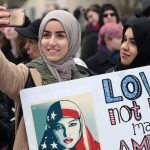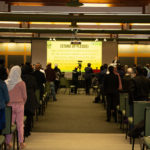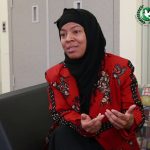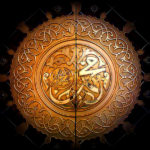by Sara Weissman
WHY HIJAB?
From the businessman’s suit to a goth’s band T-shirt, we all know that clothes are more than cloth. What we choose to wear is a sign of who we are, what we aspire to be, and how we choose to represent ourselves. So imagine wearing your heart on your sleeve, or rather your religious devotion over your head. The concept of hijab, the headscarf worn by Muslim women, is less simple than it seems.
For this month’s Challenge to the Editor, I wore hijab for one day. Hijab, which literally means “to veil,” is the code of modesty for Muslim women past puberty. The requirements for hijab consist of covering most of the body including hair and avoiding perfume and tight, transparent, or flashy clothing.
The choice to try wearing hijab for a day was as much as an internal experiment, as an external one. Considering the scary and relatively new phenomenon of Islamophobia, part of it was to see if people treated me differently. But more than that, it was a way to take a tiny glimpse into something larger, a practice meaningful to millions of people and the idea that, though the clothes don’t make the woman, they can say a lot about what she believes in.
A LITTLE BACKGROUND:
Before taking scarf in hand, I wanted a better understanding of where the idea of hijab comes from. Though there are multiple references to hijab in the Qur’an, in al-Ahzaab 33:59 it says, “O Prophet! Tell your wives and your daughters and the women of the believers to draw their cloaks all over their bodies. That will be better, that they should be known (as free respectable women) so as not to be annoyed. And Allaah is Ever Oft-Forgiving, Most Merciful.” Another, al-Noor 24:31, says, “And say to the believing women…that they should draw their veils over their bosoms and not display their beauty except to their husbands, their fathers, their husbands’ fathers, their sons, their husbands’ sons, their brothers…” and it goes on to list others.
After reading the above paragraph, your inner American, feminist may be a little miffed. Mine was too. In fact she grumbled quite a bit about the seeming patriarchal tone, the same I struggle with when discussing women’s modesty in my own religion. But many Muslim women feel very differently. In fact, they feel quite the opposite, embracing hijab as a freeing as opposed to forced expression of their faith.
“For me, the hijab is more than modesty; it is a liberating fact,” said Sara Khalil, 25. Born in Saudi Arabia, Khalil lives in Canada and has been wearing hijab since 2005. “It has allowed me to perceive myself as an individual outside the bounds of physical beauty and attraction, and further project a confidence that is independent of others’ judgment,” she said. Samara Gabriel, who converted to Islam in 2010 and runs a blog called ImInItForTheScarves.com, holds a similar view. “My body is a private thing. Mine,” she said. “Not to be shared with the world. It also means that I dress to please God, not men on the street.” Gabriel’s beliefs were reaffirmed by an incident with her editor, when she worked for a local newspaper. “The editor angrily made the comment ‘What if I WANTED to look at you?’ As if it was his right. That is a good example as to why I love wearing it. I don’t feel anymore as if I need to flip my hair around or show off my boobs or my butt to get attention. I love Pink’s ‘Stupid Girls’ as an example to what I mean,” she said.
Zara Asad, 19, explained that hijab for her is also an expression of her spiritual struggle. “It’s the covering, the cloth that protects my heart from any filth coming in,” said Asad. “It’s my shield. Everyday is a battle against improving myself and fighting distractions around me. It’s a very vital part of me.” Asad began wearing hijab when she was 17. Though both her mother, originally from Pakistan, and her sister wore it, she was afraid of what her friends and predominantly white, New Jersey community would think. But after she wore hijab, Asad said she could never go back. “When I first wore the hijab I felt like myself, a Muslim, for the very first time in public,” she said. “I felt like I could breathe for the first time.”
Others also relate to this sense of identity that comes with hijab “Our hijab is both our modest covering and a badge of our identity, “ said Rania Abuisnaineh, a 20 year old from Minnesota with family from Hebron. “People immediately recognize us as Muslim when they see our hijab, just as they recognize a Jewish man from his yarmulke or a Sikh from his turban.” However for her and others, hijab’s meaning lies in more than identity and modesty, but in the belief that it is a law from God. “When people ask me why I wear hijab, my first response is always this: ‘Because it is a command from Allah; and He knows what is best for His creation more than the creation know what is best for themselves,’” Abuisnaineh said.
Still, reactions to hijab in the modern world can be mixed and some Muslim women see a disconnect between who they are and how they are perceived. .” Shameela, however, who was born in India and now lives in Qatar, has seen these perceptions overcome. One of few Muslims in her city, she wore hijab since she was 12 and said that when she went to college, her friends saw a new side to Muslims through her activism at the university. “They came to know that wearing hijab is not a sign of oppression, and that wearing it does not make any women inferior.” Hind Yousef Khalifa, who is a resident of Abu Dhabi, also elaborated on this point. “It (hijab) doesn’t stop a woman from practicing any aspect of her everyday life,” she said. “We study, we drive, we work, we go out with friends, we volunteer and do community work and are very active in society.”
A DAY WITH HIJAB:
With all of these women’s words in mind, on a Wednesday morning over winter break I decided to put on hijab. I stood in front of the mirror, staring at the red cloth clutched in one hand and three safety pins in the other. Following the careful steps of a youtube tutorial, I slowly wrapped and pinned until the fabric finally resembled a headscarf. I looked up at the mirror, proud and a little unused to the lack of auburn frizz in the reflection that staring back at me.
With some self-conscious jitters, I went about my day as usual. I drove my family to the doctor’s, looked at old pictures with my mom, and spent the rest of the day at Fashion Island, looking for belated Chanukah gifts and hanging out with my grandma. But, I felt different. Even if it wasn’t my own religion, I suddenly felt like I had to reflect what the scarf represented. I tried walking straighter, grinned at strangers, and tacked extra pleases and thank yous on every sentence to the sales clerks at Macy’s. Despite feeling like I looked different, wearing hijab made me feel more comfortable in some ways. It reminded me of those mornings when you put on a favorite a baggy sweater, too relaxed to dress to impress. There was a certain calm in feeling like I didn’t have to look cute for anyone.
At the same time, wearing hijab attracted some unwanted attention. Walking through Fashion Island produced long stares, mostly curious but a few hostile. One man continued glaring even after I looked him in the eye while a saleswoman, chatting up other customers, spoke curtly and would not look me in the eye at all. Still, the amazing thing is the number of odd looks was nothing compared to the number of smiles. Throughout the day, I got wide grins from absolute strangers.
I would like to say I reached some mind-blowing conclusion after thinking on the experience and unpinning my scarf that night. What I came away with was more modest, but I still think entirely worth it. After a day, I can’t claim to know what it’s like for women to wear hijab: how it feels, what they believe, or how they are treated. Still, I ended the day impressed by women willing to hide parts of themselves but at the same time stand out, for the sake of their God and their religion. In the end, the biggest lesson I learned was that clothing can be fabric or it can reflect who a person wants to be. For Muslim women, hijab is a constant reminder that they are always aspiring toward better observance of their religion. The take-home message I got from a day in hijab was we can change our clothes but more importantly our clothes can change us. The question is what do we want them to reflect?








